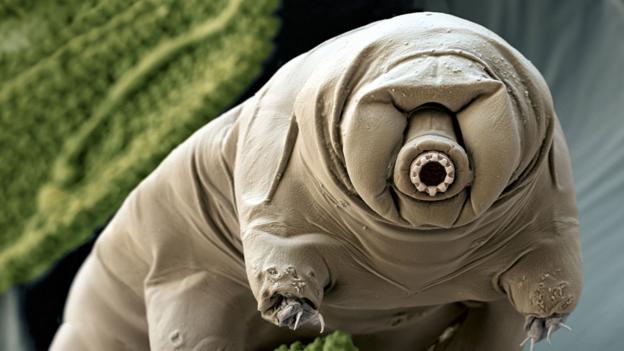
Believe it or not...this is a mocroscopic animal....They exist everywhere.Tardigrades are one of a handful of animals which can live without water
A strange creature has a trick that could change the delivery of vaccines – and other medical supplies – forever. Water is crucial for life. Or so we are told. Some organisms, it turns out, have a remarkable ability to survive near complete dehydration - a feat known as anhydrobiosis or “life without water.” There is the resurrection plant, brine shrimps, nematode worms and baker’s yeast. Or take a class of microscopic animals known as tardigrades - commonly known as water bears - which live in thin films of water present in soil, mosses, leaves, and more. “They live in water and when their habitat dries up, they dry up,” says John Crowe, a biologist at the University of California. " But they don’t die - instead, they can remain in a state of suspended animation for decades, and when they’re rehydrated, they spring right back to life."
While these remarkable resurrections are interesting curiosities in their own right, they have also inspired a wave of potentially life-saving applications. Now, scientists are beginning to copy these creatures’ tricks to preserve critical lifesaving compounds, such as vaccines, DNA and stem cells. They hope to extend the shelf life of these substances from mere days to months or even years, transforming medicine everywhere from rural Africa to the battlefield.
Early in his career, Crowe was inspired by water bears—and their remarkable capacity for dehydration. “I started this whole business with a curiosity - how do they do this?” Crowe says. “Humans can’t do this.” Indeed, when our cells dry out, they shrink and shrivel. The proteins inside them clump together and the membranes fuse, causing irreversible damage. Upon rehydration, the cells often completely disintegrate.
In the 1970s, Crowe discovered that the secret to the survival of many anhydrobiotic organisms is a simple sugar known as trehalose. As these critters dry out, they manufacture this sugar. The sugar, in turn, essentially behaves just like water inside the cell. As the water molecules disappear, molecules of trehalose slip into the spaces that the water once occupied; the proteins in the cellular membrane that were once bonded to water bond to the sugar instead. In this way, the sugar stabilizes the cell, holding its membrane in place and preventing the cell from shriveling. With trehalose inside the cell, Crowe says, “the proteins remain right where they were in the membrane, as if it were fully hydrated.”
As Crowe developed this “water replacement theory” of trehalose, he began to wonder: If trehalose could stabilize the cells of anhydrobiotic organisms, could it also be used to protect human cells from damage when they were dried? He began to realize that the biomedical implications could be huge. For instance, to stop bleeding and to secrete substances that promote wound healing. Transfusions of platelets can be life saving for patients suffering from massive blood loss, as well as those undergoing chemotherapy or certain surgical procedures. But platelets are tricky to use therapeutically. Refrigeration renders them useless, so they must be stored at room temperature. That drastically limits their shelf life; blood banks discard human platelets after just three to five days, and even then, the cell fragments occasionally get contaminated with fungi, bacteria, or viruses, causing potentially fatal complications in patients who receive transfusions. It also means there’s a chronic shortage of platelets.
If scientists could figure out how to dehydrate the platelets without destroying them, it would be a game changer.
Early in his career, Crowe was inspired by water bears—and their remarkable capacity for dehydration. “I started this whole business with a curiosity - how do they do this?” Crowe says. “Humans can’t do this.” Indeed, when our cells dry out, they shrink and shrivel. The proteins inside them clump together and the membranes fuse, causing irreversible damage. Upon rehydration, the cells often completely disintegrate.
In the 1970s, Crowe discovered that the secret to the survival of many anhydrobiotic organisms is a simple sugar known as trehalose. As these critters dry out, they manufacture this sugar. The sugar, in turn, essentially behaves just like water inside the cell. As the water molecules disappear, molecules of trehalose slip into the spaces that the water once occupied; the proteins in the cellular membrane that were once bonded to water bond to the sugar instead. In this way, the sugar stabilizes the cell, holding its membrane in place and preventing the cell from shriveling. With trehalose inside the cell, Crowe says, “the proteins remain right where they were in the membrane, as if it were fully hydrated.”
As Crowe developed this “water replacement theory” of trehalose, he began to wonder: If trehalose could stabilize the cells of anhydrobiotic organisms, could it also be used to protect human cells from damage when they were dried? He began to realize that the biomedical implications could be huge. For instance, to stop bleeding and to secrete substances that promote wound healing. Transfusions of platelets can be life saving for patients suffering from massive blood loss, as well as those undergoing chemotherapy or certain surgical procedures. But platelets are tricky to use therapeutically. Refrigeration renders them useless, so they must be stored at room temperature. That drastically limits their shelf life; blood banks discard human platelets after just three to five days, and even then, the cell fragments occasionally get contaminated with fungi, bacteria, or viruses, causing potentially fatal complications in patients who receive transfusions. It also means there’s a chronic shortage of platelets.
If scientists could figure out how to dehydrate the platelets without destroying them, it would be a game changer.





No comments:
Post a Comment
Through these open doors you are always welcome